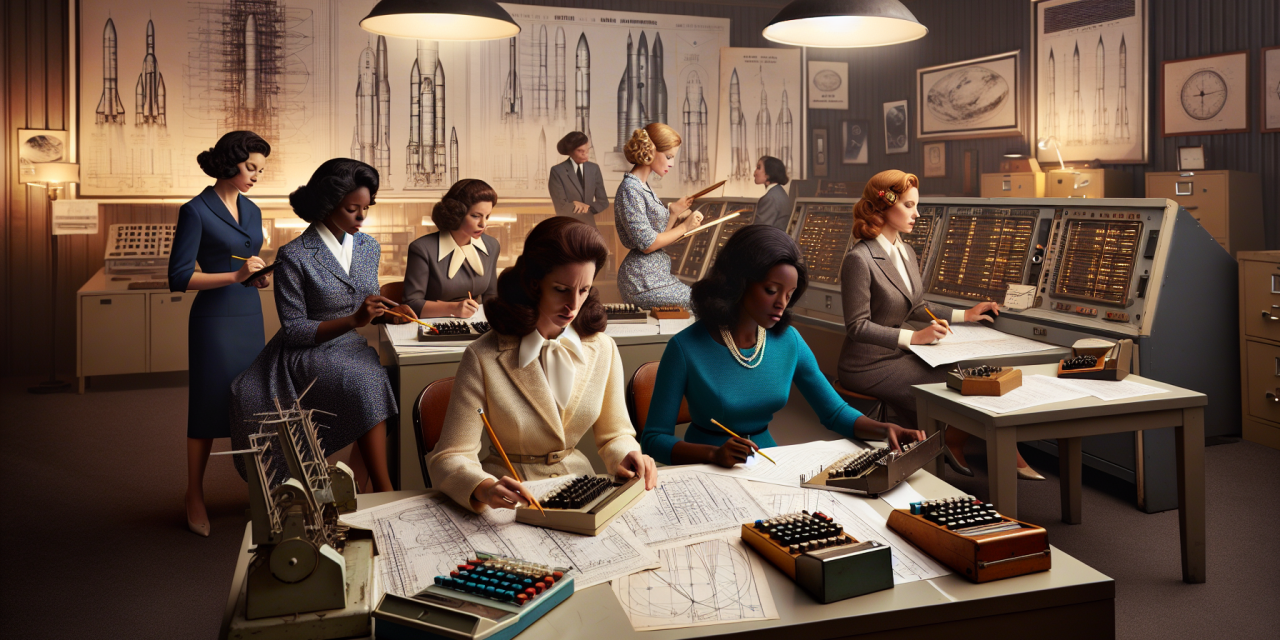Picture this: it’s 1961, and America is racing to put humans in space. While scientists and engineers work frantically on rocket designs, there’s another group of brilliant minds working behind the scenes—armed not with blueprints or prototypes, but with slide rules, pencils, and mathematical precision that would make a computer jealous. These were the human computers of NASA, and many of them were women whose names history nearly forgot.
Think of mathematics like a universal language—one that doesn’t care about your background, your gender, or what others might think you’re capable of. Numbers tell the truth, and calculations either work or they don’t. For women like Katherine Johnson, Dorothy Vaughan, and Mary Jackson, this mathematical language became their ticket to changing the world, one equation at a time.
When Humans Were the Computers
Before we had the powerful computers we rely on today, complex calculations had to be done the old-fashioned way—by hand, with extraordinary precision. Imagine trying to calculate the exact trajectory needed to launch a rocket into space, have it orbit Earth multiple times, and return safely to a specific spot in the ocean. It’s like trying to throw a paper airplane from New York and having it land on a dinner plate in Los Angeles, except the plate is moving and you only get one shot.
During the 1940s and 1950s, NASA (then called NACA) employed teams of mathematicians called “computers”—because that’s exactly what they did, they computed. These human computers performed calculations that determined whether rockets would reach their destinations or astronauts would make it home safely. No pressure at all, right?
Many of these human computers were women, and a significant number were African American women working during an era of segregation. They faced not just the technical challenge of rocket science, but also the social barriers of their time. Yet their mathematical brilliance couldn’t be ignored—numbers don’t discriminate, and neither did the urgent need for accuracy in the space program.
Katherine Johnson: The Mathematical Navigator
Katherine Johnson possessed what you might call a superpower—she could see mathematical patterns and relationships that others missed. Born in 1918, she was calculating advanced problems by age 10 and graduated from college at 18. When she joined NASA’s team of human computers in 1953, she brought with her an almost magical ability to understand orbital mechanics.
Think of space travel like a cosmic dance, where everything is moving—Earth spinning, the moon orbiting, other planets following their paths. To send a spacecraft anywhere, you need to calculate not where your target is now, but where it will be when your spacecraft arrives. It’s like trying to meet a friend at a coffee shop, except the coffee shop is moving at 17,000 miles per hour and you’re approaching from a completely different direction, also at enormous speed.
Johnson’s breakthrough moment came with John Glenn’s orbital mission in 1962. The electronic computers—those room-sized machines that were brand new at the time—had calculated Glenn’s trajectory. But Glenn himself requested that Johnson personally verify the computer’s work. “Get the girl to check the numbers,” he said. If Katherine Johnson said the math was correct, he would fly. The trust placed in her mathematical abilities literally meant the difference between life and death for America’s first orbital astronaut.
Her calculations were so precise that when Apollo 11 needed to navigate to the moon and back, Johnson’s mathematical techniques helped guide humanity’s first steps on another celestial body. Every time you use GPS to navigate or track a satellite weather report, you’re benefiting from approaches that Johnson pioneered.
Dorothy Vaughan: The Programming Pioneer
Dorothy Vaughan had the rare ability to see the future before it arrived. In the late 1950s, she realized that electronic computers would eventually replace human computers—but rather than resist this change, she decided to master it. Like someone learning a new language before moving to a foreign country, Vaughan taught herself FORTRAN, one of the first computer programming languages.
But Vaughan didn’t just learn programming for herself—she taught it to her entire team. Picture a teacher who not only stays ahead of technological change but ensures that everyone in her classroom can adapt and thrive. This wasn’t just kindness; it was strategic brilliance. By preparing her colleagues for the digital transition, Vaughan ensured that their mathematical expertise wouldn’t become obsolete.
Vaughan became NASA’s first African American supervisor, leading a team of human computers and later transitioning them to electronic computer programming. She understood something that many people still struggle with today: technology doesn’t replace human intelligence—it amplifies it. The same mathematical thinking that made her an excellent human computer made her an exceptional programmer.
Her approach to problem-solving reminds us that programming isn’t really about computers—it’s about breaking complex challenges into logical steps that can be solved systematically. Whether you’re calculating rocket trajectories by hand or writing code to automate those calculations, the fundamental thinking process remains remarkably similar.
Mary Jackson: The Boundary Breaker
Mary Jackson faced a particularly complex equation—one that involved not just mathematics and engineering, but also navigating social barriers that seemed designed to keep her out. To become an engineer at NASA, she needed additional courses that were only offered at an all-white high school. Instead of accepting this limitation, Jackson petitioned the courts for permission to attend, becoming the first African American woman to crack the engineering barrier at NASA.
Think of Jackson’s challenge like debugging a program with multiple interconnected problems. You can’t just fix the technical issues; you also have to address the systemic barriers that prevent the program from running properly. Jackson worked on both levels simultaneously—advancing her technical skills while advocating for changes to the institutional structures around her.
Her engineering work focused on understanding how air flows over aircraft surfaces—research that improved airplane design and safety. But perhaps more importantly, her career path created a template that others could follow. By becoming the first, she made it possible for others to be the second, third, and hundredth.
Jackson eventually transitioned from engineering to equal opportunity advocacy, working to help other women and minorities enter STEM fields. She understood that sustainable change requires not just individual achievement, but systematic effort to provide opportunities for others.
The Ripple Effect of Mathematical Courage
The story of these hidden figures illustrates something profound about how progress happens in science and technology. Breakthrough moments don’t usually come from lone geniuses working in isolation—they emerge from diverse teams where different perspectives combine to solve complex challenges.
Each of these women brought unique strengths: Johnson’s intuitive grasp of orbital mechanics, Vaughan’s strategic vision for technological transition, and Jackson’s determination to break down institutional barriers. Together, their contributions helped transform the United States from a country struggling to keep up in the space race to one capable of landing humans on the moon.
Their influence extends far beyond the calculations they performed or the programs they wrote. They demonstrated that mathematical and technical excellence can emerge from unexpected places, that diversity strengthens problem-solving teams, and that persistence in the face of barriers often produces the most innovative solutions.
Today, when you see women and minorities in STEM fields, many trace their inspiration back to stories like these. The hidden figures of NASA didn’t just calculate rocket trajectories—they calculated new possibilities for what careers in science and technology could look like.
Lessons for Today’s Coders
The legacy of Johnson, Vaughan, and Jackson offers valuable insights for anyone interested in technology and problem-solving today. First, they remind us that the most important skill isn’t knowing specific tools or technologies—it’s developing the ability to think systematically about complex problems.
Katherine Johnson didn’t just memorize formulas; she understood the underlying mathematical relationships well enough to adapt them to new challenges. Dorothy Vaughan didn’t just learn FORTRAN; she grasped how programming could amplify mathematical thinking. Mary Jackson didn’t just study engineering; she recognized how social and technical systems interconnect.
Second, their stories highlight the importance of continuous learning and adaptation. Each of these women encountered technological changes that could have made their skills obsolete. Instead, they chose to evolve, learning new approaches while building on their foundational strengths.
Perhaps most importantly, they understood that technical work has social dimensions. The calculations they performed weren’t just abstract mathematical exercises—they were solutions to human challenges that required collaboration, communication, and the ability to build trust with colleagues and decision-makers.
Their approach reminds us that coding and mathematical thinking aren’t just about creating elegant solutions—they’re about using those solutions to expand what’s possible for yourself and others. Every time you write a program, solve a mathematical problem, or approach a challenge systematically, you’re participating in the same tradition of logical thinking and persistent problem-solving that sent








